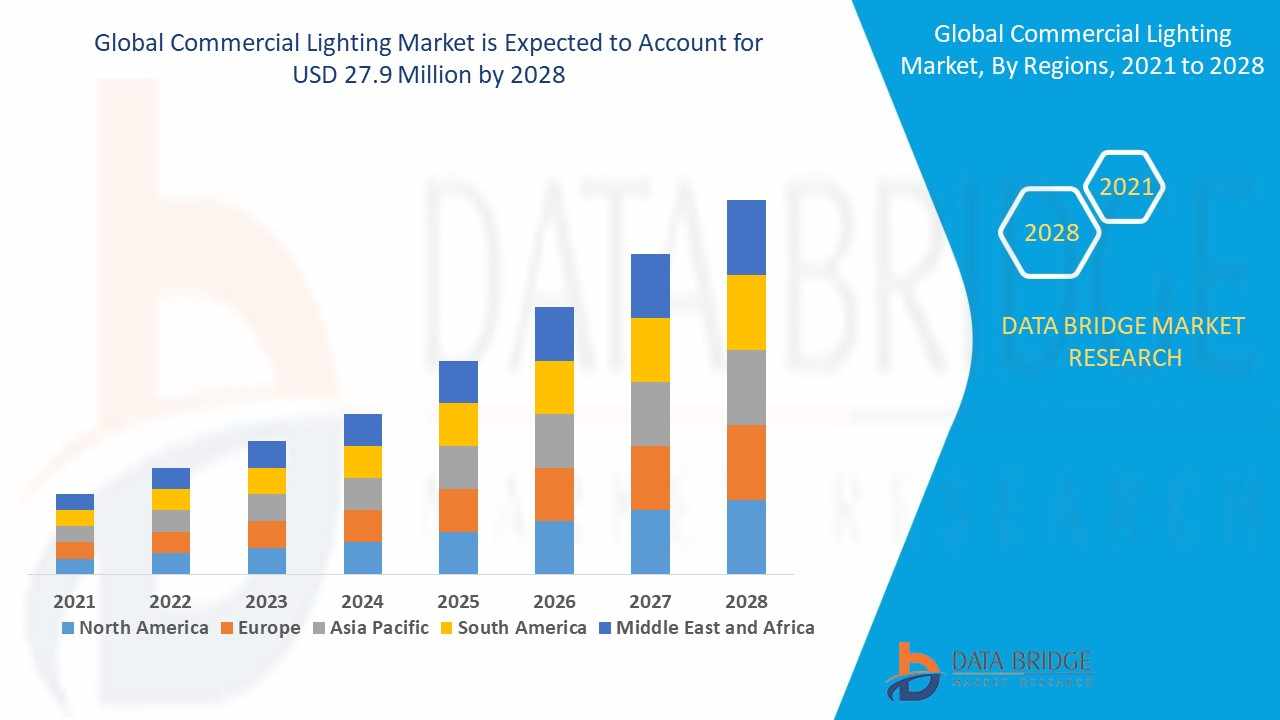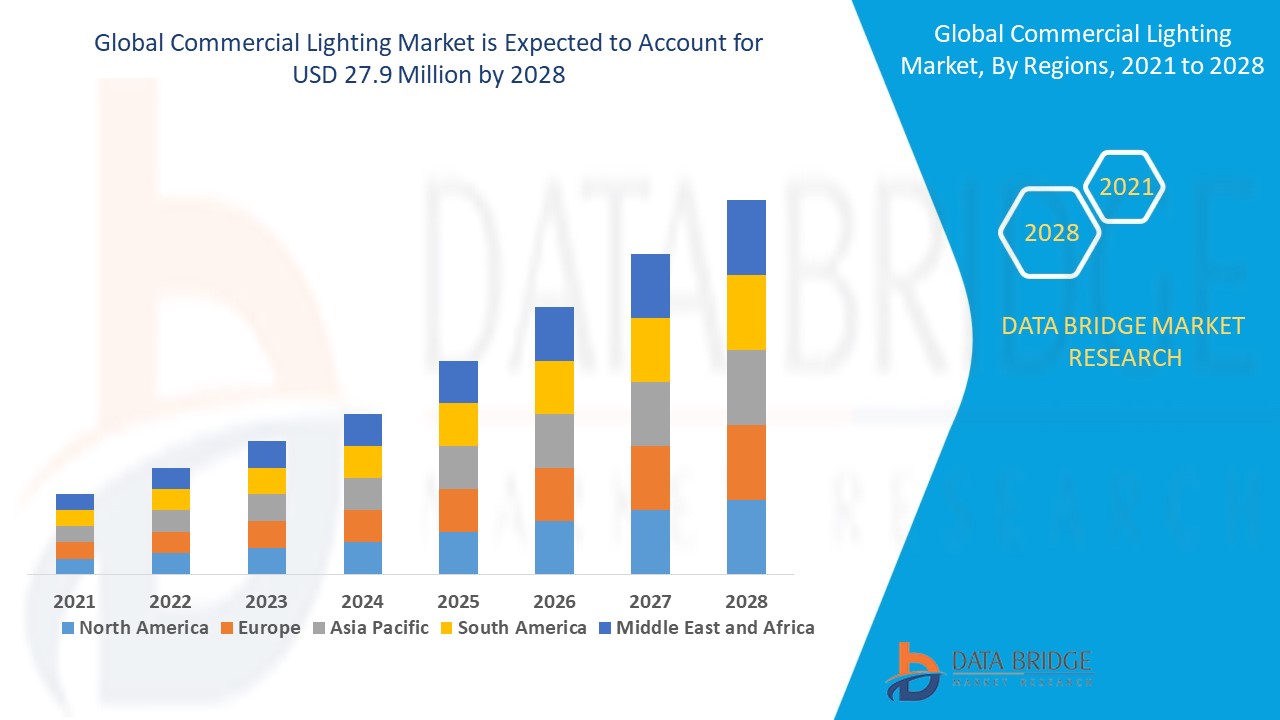
Lighting is more than just illumination; it's a fundamental element shaping commercial spaces, impacting productivity, aesthetics, and energy consumption. The commercial lighting market is undergoing a profound transformation, driven by technological advancements, environmental consciousness, and evolving user demands.
Commercial lighting market will reach at an estimated value of USD 27.9 million by 2028 and grow at a CAGR of 20.10% in the forecast period of 2021 to 2028.
Access Full 350 Pages PDF Report @
Introduction
The commercial lighting market encompasses a vast array of lighting solutions for diverse applications, including offices, retail stores, manufacturing facilities, warehouses, healthcare institutions, and hospitality venues. Historically dominated by traditional incandescent and fluorescent technologies, the industry has seen a dramatic shift towards more energy-efficient and intelligent solutions. This evolution is not merely about brighter lights but about creating smart, adaptive, and human-centric environments that contribute to the overall well-being and operational efficiency of businesses.
Market Size
The commercial lighting market is experiencing robust growth, primarily propelled by the widespread adoption of LED technology. The industrial and commercial LED lighting market alone was valued at $64.36 billion in 2024 and is projected to reach $77.98 billion in 2025, demonstrating a significant compound annual growth rate (CAGR) of 21.1%. Looking further ahead, this segment is anticipated to grow to $165.32 billion by 2029, with a CAGR of 20.7%. Broader commercial lighting market estimates indicate a valuation of USD 13.97 billion in 2023, with projections to reach USD 79.47 billion by 2032, growing at an impressive CAGR of 21.36% from 2024 to 2032. This substantial expansion is fueled by the increasing construction of new commercial structures and the ongoing wave of retrofitting existing buildings with modern lighting systems.
Market Share
Within the commercial lighting landscape, certain segments and technologies hold significant market share. LED-based lighting has emerged as the undisputed leader, commanding approximately 73% of the total market share in 2024. This dominance is attributed to LEDs' superior energy efficiency, longer lifespan, and declining product prices. The luminaires segment also plays a crucial role, holding about 76% of the total market share in 2024, reflecting the demand for complete lighting fixtures.
Geographically, Asia-Pacific is a major player, often recognized as the largest and fastest-growing market. Commercial office lighting remains the dominant application segment, accounting for roughly 39% of the market share in 2024, driven by the emphasis on creating productive and energy-efficient workspaces. Key industry players influencing market share include global giants such as Signify NV (Philips Lighting), Acuity Brands Inc., Hubbell Incorporated, and Osram, among others.
Market Opportunities and Challenges
The commercial lighting market presents numerous opportunities for innovation and growth. The rising demand for energy-efficient solutions and smart control systems is a significant driver. The integration of IoT (Internet of Things) with lighting systems, enabling remote control, automation, and data-driven insights, is creating new avenues. Human-centric lighting (HCL), which adjusts light color and intensity to mimic natural daylight cycles to improve well-being and productivity, is a rapidly expanding area. Furthermore, the increasing focus on sustainable lighting solutions, including those made from eco-friendly materials and powered by renewable energy like solar, offers considerable potential. The growth of smart cities initiatives also creates opportunities for integrated and intelligent outdoor lighting solutions.
Despite these opportunities, challenges persist. The initial investment costs for upgrading to advanced LED and smart lighting systems can be a barrier for some businesses, although the long-term energy and maintenance savings often outweigh this. The need for a skilled workforce for the installation and maintenance of complex smart lighting systems also presents a challenge. Additionally, ensuring interoperability between different smart lighting platforms and addressing potential cybersecurity concerns related to connected lighting systems are ongoing considerations. The market also faces intense competition from new entrants offering innovative technologies and competitive pricing.
Market Demand
The demand for commercial lighting is intrinsically linked to construction activity, economic development, and the increasing emphasis on energy efficiency and sustainability. There is a strong demand for lighting solutions that not only provide illumination but also contribute to cost reduction through lower energy consumption and reduced maintenance needs. Businesses are actively seeking solutions that enhance productivity, improve employee well-being, and create aesthetically pleasing environments. This translates into a growing demand for tunable white lighting, which allows for adjustment of color temperature, and integrated lighting systems that offer comprehensive control and monitoring capabilities. The demand for retrofit installations, replacing older, less efficient lighting systems with modern LED alternatives, remains robust across various commercial sectors.
Market Trends
Several key trends are shaping the future of commercial lighting:
Smart LED Lighting and IoT Integration: This is a dominant trend, with intelligent systems offering precise control over lighting levels, color temperature, and scheduling, often managed through intuitive dashboards and integrated with building management systems.
Human-Centric Lighting (HCL): Beyond basic illumination, HCL focuses on improving occupant comfort, mood, and productivity by mimicking natural light patterns.
Sustainability and Circular Economy: There's a growing emphasis on eco-friendly materials, energy-efficient designs, and the recyclability of lighting components, aligning with global sustainability goals.
Network Lighting Controls (NLCs): These systems are gaining traction as organizations seek smarter and more efficient ways to manage large-scale lighting installations, offering enhanced energy savings and centralized control.
Li-Fi Technology: While still emerging, Li-Fi, which uses light waves for high-speed data transmission, holds potential for secure and interference-free data communication in certain commercial environments.
UV-C Lighting for Hygiene: Driven by increased awareness of hygiene, particularly in healthcare and food processing, UV-C lighting for disinfection is gaining prominence.
Modular and Scalable Lighting: The ability to easily adjust and reconfigure lighting systems to adapt to changing commercial needs is becoming a key differentiator.
Integration with AI: AI-powered lighting systems are being developed to understand environmental conditions and occupant behavior, optimizing lighting levels and color temperatures for maximum productivity and comfort.
Enhanced Rebates and Incentives: Governments and utility companies are increasingly offering significant rebates and incentives for businesses to upgrade to energy-efficient LED and smart lighting solutions, further accelerating adoption.
The commercial lighting market is dynamic and innovative, constantly evolving to meet the complex demands of modern businesses. As technology advances and sustainability becomes an even greater imperative, intelligent and adaptable lighting solutions will continue to play a pivotal role in shaping the commercial spaces of tomorrow.
Contact Us:
Data Bridge Market Research
US: +1 614 591 3140
UK: +44 845 154 9652
APAC : +653 1251 975








Write a comment ...